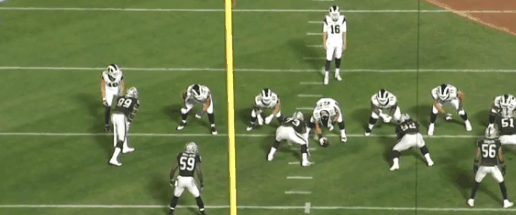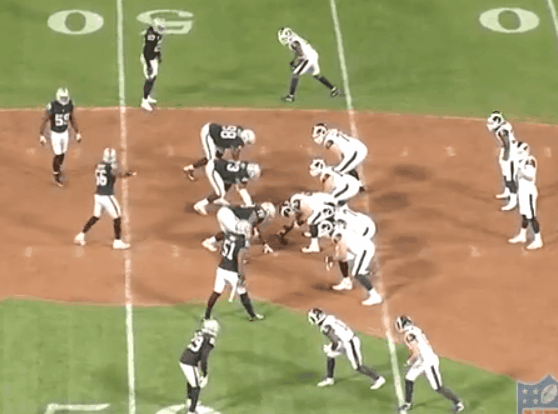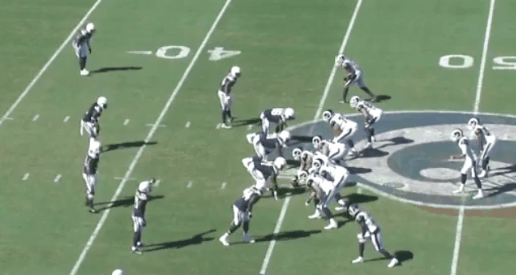It all started when Los Angeles Rams RB Todd Gurley took one 19 yards for a touchdown against the Oakland Raiders on Monday Night Football in Week 1:
[embedded content]
And with that, the chestpunt was born — Rams Head Coach Sean McVay’s new wrinkle for 2018 in which QB Jared Goff heartheaves the ball for a crossing target to take laterally almost immediately after the ball is snapped.
Given the Rams’ other lateral carry motion in their offense coupled with the threat of playaction, the chestpunt has become notable as much for its success as its identifiable stature.
There’s no missing it.
What has been interesting is the evolution (and devolution) of the chestpunt as we near the halfway point of the 2018 season.
Heading into Week 8, the Rams have run the chestpunt 11 times while running playaction off of it 14 times. It’s become a lightning rod for its unique playshape as well as the results it has borne. Here’s what it has looked like when it’s worked well and, welp, when perhaps it hasn’t been the most effective.
Chestpunt #1
Week 1 @ OAK
19-yard TD by RB Todd Gurley

So this was our first exposure to chestpunt levels above 0.
The playcall itself is enough to create favorable conditions combined with the slow early motion from Gurley, but what really sets up the touchdown is the blocking from WR Cooper Kupp and WR Brandin Cooks.
Gurley doesn’t have to do anything special. He goes in untouched:

This is the chestpunt at its finest. A combination of a play design that takes a defense by surprise and puts a player like JTG in space.
But it’s not just the chestpunt itself. The mere threat of it can be sufficient to create structural advantages.
Chestpunt #2
Week 1 @ OAK
23-yard reception by WR Brandin Cooks
From the same game in the third quarter, the Rams run a chestpunt playaction that results in a long gain for Cooks. Forget the reception and look at the action up front:

The chestpunt action delays the blitz from Raiders CB Leon Hall (#29) giving LT Andrew Whitworth plenty of time to adjust for him. It also forces S Reggie Nelson (#27) to arc his blitz to account for Kupp on the other side.
So in the first game, McVay was able to implement the chestpunt and a chestpunt playaction to add to the lateral motion in his offense even after moving on from WR Tavon Austin. After just two playcalls, McVay was now forcing opposing teams to include chestpunt defensive options into their game preparations without being sure whether the action would come from Gurley or a wideout.
In Week 2, McVay upped the chaos.
Chestpunt #3
Week 2 v. ARI
9-yard chestpunt by WR Brandin Cooks

What in the what? The double chestpunt?!
After stalling out on their first two drives leaning into forcing the run, the Rams had a drive going leading to this chestpunt as the first play of the 2nd quarter. Gurley comes across from the right but right on the snap, Cooks comes from the weakside slot. Gurley would score on the next play to open the scoring for the Rams on the day.
They chestpunted again later in the quarter to WR Cooper Kupp in the redzone to get the Rams down to the six-yard line, but couldn’t get it in.
But even then, teams hadn’t completely bought into the threat of the chestpunt…
Chestpunt #4
Week 3 v. LAC
2-yard run by RB Todd Gurley


This one comes almost midway through the first quarter as things remained scoreless. As you can see in the second GIF, Los Angeles Chargers S Jahleel Addae signals to rookie S Derwin James before attacking the Gurley handoff. He barely flinches at the Cooks chestpunt playaction. And from the first GIF, we see that Cooks could have racked up a ton had it been the playcall instead of using him on playaction.
McVay would take advantage of that in the third quarter.
Chestpunt #5
Week 3 v. LAC
15-yard chestpunt by WR Brandin Cooks

Even with RB Malcolm Brown in the game for Gurley, Addae and DE Chris Landrum weren’t set to defend Cooks’ speed on the chestpunt. The first down kept the Rams’ drive going and ultimately went for a touchdown to put them up two scores.
In each of the first three games, the Rams ran two plays that included chestpunt action.
In Week 4 against the Minnesota Vikings, it became a central part of the offense.
The Rams would include chestpunt on four various plays including one that led to the best throw of Goff’s NFL career.
Chestpunt #6
Week 4 v. MIN
19-yard TD reception by WR Cooper Kupp
[embedded content]
Here, the chestpunt action doesn’t affect the outcome much. If anything, it’s good evidence that it’s just a normal part of the offensive scheme.
Plus, I just wanted to post that damn throw again.
In Week 5, the Rams ran the chestpunt more than any game this season. Most of them were conventional chestpunt playaction that by this point you understand.
This play, though, was new:
Chestpunt #7
Week 5 v. SEA
2-yard run by RB Todd Gurley
After a punt block by LB Cory Littleton set the Rams up with a 1st down inside the red zone, McVay dialed up a first:
A chestpunt playaction run.

Wrinkles on wrinkles on wrinkles.
So what made me think about looking at this as a playcall?
Complaints about the chestpunt in the last two weeks when it didn’t work.
Chestpunt #8
Week 6 v. DEN
Incomplete pass to RB Todd Gurley
Going back throughout every offensive snap this season, the Denver Broncos were the first team who were completely prepared for the chestpunt. This isn’t to say it wasn’t effective. Much like a conventional run against a defense that expects it, the Rams ran a chestpunt to Gurley in the early 2nd quarter for 13 yards to get into the redzone. If anything, it reinforced the suggestion that the chestpunt is just a standard part of the playbook at this point as much as a traditional handoff run.
But this one chestpunt had fans criticizing McVay for getting too cutesy:

There were gasps when the ball hit the grass, but this call reminded us that the chestpunt is a forward pass and thus incomplete and not a fumble. Also a good note here is that it was the first drop. So as an anomaly, this stood out in general and probably contributed to the criticisms at the time from fans. But as I’ve mentioned, many of those criticisms are for outputs not inputs.
We’ve seen the chestpunt work very effectively before. It didn’t here. That it didn’t shouldn’t be a general criticism of the chestpunt, at least not at this point. As I mentioned, a quarter later a chestpunt to Gurley picked up a first down and set the Rams up in the red zone for an eventual Gurley touchdown.
But it’s just very hard to shrug off when the chestpunt doesn’t work.
And yet again in Week 7, we had a new version that did not work. At all.
Chestpunt #9
Week 7 @ SF
-5-yard TD reception by TE Gerald Everett

Yeah, no.
So, we have our wrinkle for 2018. The chestpunt.
It’s not perfect. And it’s not the Philly Special, a secret play to run once in a key situation. No, this is our weekly wrinkle. An everygame reminder of the genius of McVay. Ever evolving. Ever probing toward a new frontier of football.
And whether it’s using it for Everett or using a WR chestpunt motion to hand it off to Gurley or a double chestpunt, there will always be new frontiers.
And that’s what the chestpunt is. McVay’s Enterprise.
Let’s get ready to explore.
